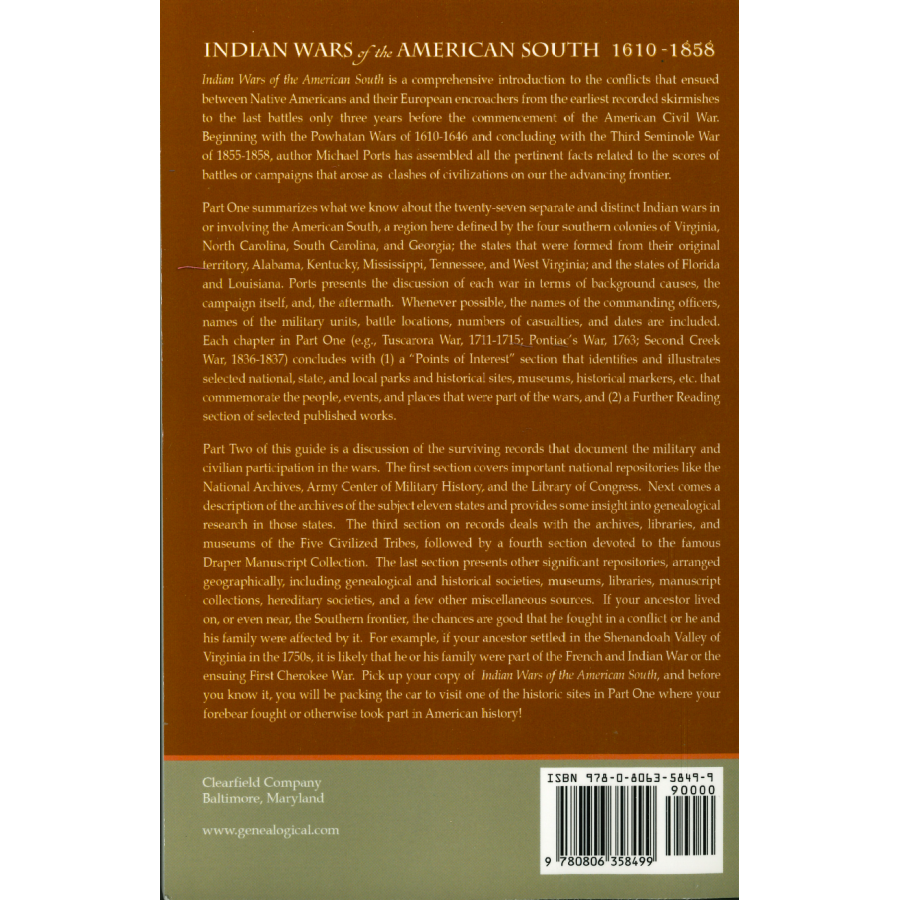Indian Wars of the American South, 1610-1858: A guide for Genealogists and Historians
Couldn't load pickup availability
This is a comprehensive introduction to the conflicts that ensued between Native Americans and their European encroachers from the earliest recorded skirmishes to the last battles only three years before the commencement of the American Civil War. Beginning with the Powhatan Wars of 1610-1646 and concluding with the Third Seminole War of 1855-1858, author Michael Ports has assembled all the pertinent facts related to the scores of battles or campaigns that arose as clashes of civilizations on the advancing frontier.
Part One summarizes what we know about the twenty-seven separate and distinct Indian wars in or involving the American South, a region here defined by the four southern colonies of Virginia, North Carolina, South Carolina, and Georgia; the states that were formed from their original territory, Alabama, Kentucky, Mississippi, Tennessee, and West Virginia; and the states of Florida and Louisiana. Ports presents the discussion of each war in terms of background causes, the campaigns itself, and, the aftermath. Whenever possible, the names of the commanding officers, names of the military units, battle locations, numbers of casualties, and dates are included. Each chapter in Part One (e.g., Tuscarora War, 1711-1715; Pontiac's War, 1763; Second Creek War, 1836-1837) concludes with (1) a "Points of Interest" section that identifies and illustrates selected national, state, and local parks and historical sites, museums, historical markers, etc., that commemorate the people, events, and places that were part of the wars, and (2) a Further Reading section of selected published works.
Part Two of this guide is a discussion of the surviving records that document the military and civilian participation in the wars. The first section covers important national repositories like the National Archives, Army Center of Military History, and the Library of Congress. Next comes a description of the archives of the subject eleven states and provides some insight into genealogical research in those states. The third section on records deals with the archives, libraries, and museums of the Five Civilized Tribes, followed by a fourth section devoted to the famous Draper Manuscript Collection. The last section presents other significant repositories, arranged geographically, including genealogical and historical societies, museums, libraries, manuscript collections, hereditary societies, and a few other miscellaneous sources. If your ancestor lived on, or even near, the Southern frontier, the chances are good that he fought in a conflict or he and his family were affected by it. For example, if your ancestor settled in the Shenandoah Valley of Virginia in the 1750s, it is likely that he or his family were part of the French and Indian War or the ensuing First Cherokee War. Pick up your copy of Indian Wars of the American South, and before you know it, you will be packing the car to visit one of the historic sites in Part One where your forebear fought or otherwise took part in American history.
Michael A. Ports
2017, 6" x 9", paper, 397 pp.
ISBN: 9780806358499
102-8511
